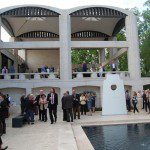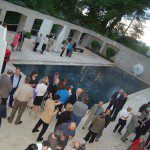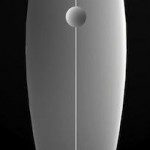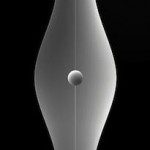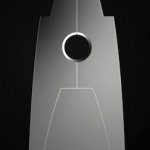Dreyfuss at the Kreeger: Union of City and Culture
By • June 25, 2013 0 2529

People in the culture-noticing business often talk about Washington, D.C., treasures, hidden or obvious. They mean old, historical homes passed into museum-stage, museums in our midst of which we and, therefore, tourists are often unaware, as well as the artists or performers of national and international renown who live in our midst.
This sort of thing—treasures in our midst that sometimes go, if not unheralded, perhaps at times under-appreciated—is especially true in Georgetown and its surrounding neighborhoods, place historic and cultured by nature and fact.
The occasion of the launching of an exhibition of four sculptures by John Dreyfuss at the Kreeger Museum on Foxhall Road was a kind of serendipitous event which brought members of the Georgetown community, the city’s art community and the folks at the Kreeger, including family members, together. The show is meant to showcase the three pieces by Dreyfuss—who is represented by George Hemphill of Hemphill Fine Arts, which was and remains one of the gallery jewels of the city—and the addition of the Kreeger’s reflecting pool as a new exhibition space.
The Kreeger began as the home for David and Carmen Kreeger, designed by prize-winning, much-honored architect Philip Johnson in 1963. It opened its doors as the Kreeger Museum in 1994 under director Judy Greenberg. It sits along upscale Foxhall Road in a changing area where developments have sprouted in recent years. Far from most of the city’s museums, especially along the mall and downtown, it still casts a large shadow with its incomparable collection of paintings and sculptures and works of art, including an inviting hallway that is a kind of pathway of the career of Pablo Picasso.
The addition of a reflection pool for exhibition purposes is a perfect fit for the Kreeger’s existing sculpture terrace and sculpture Garden. Also fitting are the three pieces by Dreyfuss from his “Inventions” series in their scale and intent, their execution as clean, bold fabrications that inhabit both the living now and the coming future in a primal way, as if a clarion call.
Dreyfuss himself, the holder of a world reputation as a sculptor who uses modern materials and thinks and creates in an epic way, is also a long-time treasure in the flesh, so to speak. His work has consistently impressed for years, including those years when he worked in his studio at Halcyon House, something of a historic treasure as well. Dreyfuss has since moved out of Georgetown to the new condos of Southwest D.C.
The exhibition opening was a kind of showcase for both the Kreeger Museum and sculptor Dreyfuss along with the idea of cultural leadership and cultural treasures—the art as well as the artists among us—on full display in our midst. Long-time Georgetowners showed up, members of the Kreeger family, writers and national leaders to bask in the beautiful setting which off-and-on-again showers and storms actually managed to enhance. Art is not so easily diminished or subdued.
The sculptures of Dreyfuss—three more will be added in honor of the Kreeger Museum’s 20th anniversary next year—are the kind of work that demands and suggests reviewing on different moods, on different days from different angles.
The Kreeger Museum itself—bolstered no doubt by the occasion—is the kind of place which makes you reluctant to leave. You want to convene with the lone Van Gogh, with the many Picassos, with the Henry Moore sculpture or the large head inside a window and think about music played at eveningtide here.
In this way, the day and the night became a treasure at the museum, too.
John Dreyfuss’s “Inventions” runs through May 1, 2015, at the Kreeger Museum, 2401 Foxhall Road, N.W. — www.KreegerMuseum.org.
- Sculptor John Dreyfuss with Judy Greenberg, director of the Kreeger Museum | Robert Devaney



